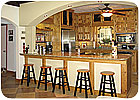
When Tim McGuire figures it’s time for another major renovation to his home, he doesn’t have to go far for creative advice or expert craftsmanship to turn his place into an architectural showpiece, strong on the “wow-factor,” and well suited for his growing family.
As production supervisor for Green Country Interiors–the largest drywall and ceiling contractor in Tulsa, Okla.–he has plenty of experience with every sort of commercial and residential construction, high-end and low-end. He grew up working for his father’s contracting firm in Tulsa, then moved to southern California after high school, where he honed his skills in the industry for a decade. He returned to suburban Tulsa, about 10 years ago where he and his wife have four children aged three to 16.
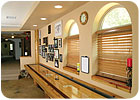
California connection
In California, “I did everything, from high-rises to casinos, to Palm Springs golf resorts,” McGuire said. He also worked on the famous local landmark on the Pacific Coast Highway in Huntington Beach, Jack’s Surf Shop. These experiences gave him the creative confidence to take his craft to new heights, not only on commercial, but residential projects. His own home is a case in point.He has just finished the fourth–and possibly the final phase–of a 10-year project that has transformed his 1,600 square-foot, 60-year-old home into a 4,000-square-foot masterpiece that bears no resemblance to its former ordinary self. The first phase was focused on the garage a decade ago when he bought the house. “I raised ceilings, tore out walls and turned the garage into a master bedroom and added a master bathroom,” he explained.
The rest of the remodeling began about three years ago in three distinct phases: An 1,800-square-foot family room and loft addition; EIFS exterior on the whole structure, replacing vinyl siding; and a complete remodel of the kitchen.
“I knew pretty well what I wanted to do and was able to incorporate into the house some bold ideas from commercial projects I’ve done over the years,” McGuire told Walls & Ceilings. He did nearly the whole interior, from design to construction, by himself, with periodic assistance from family and friends. Working evenings and most weekends, the most visible and dramatic phase-the 1,800 square-foot addition that is mainly a family room–was completed in about four months.
For the family room addition, McGuire aimed for an airy ‘lodge effect’ in the massive space. He executed the design masterfully, using huge log pillars around the wet bar area, with matching split-logs as trim throughout the room. He used knotty pine cabinetry and bookshelves in the area surrounding the fieldstone fireplace.
McGuire made exquisite use of his expertise with drywall and metal framing, as he designed a complex serpentine soffit around the whole room, with an additional two levels of curved soffits over the wet bar. Two tones of paint, off-white and beige, were used on the ceiling to further dramatize the unique design. Additionally, the drywall was finished with a heavy “knock-down” texture, to give an adobe appearance.
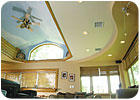
Swerves and curves
Because he has designed and installed quite a bit of drywall in commercial projects, McGuire said he was extremely confident as he approached the serpentine design of the soffits. One trick that made the project easier was mixing the use of wood and metal for ease of construction. He chose to use Flex-C Trac, manufactured by Flexibility Concepts for the curves.“I’ve done a lot of commercial curves in the same way, and finally had a chance to do it on my own house,” he explained. “It’s not hard to design. I’ve done casinos and many other different stylish things, so I knew exactly what I needed to do.”
McGuire laid out the design of the soffits on the concrete floor. “First, I measured out a few areas on the floor, from the perimeter wall to how far I wanted them to go in and out, and finalized each particular section with an ending point by the window. Then I hand-drew connection points, sometimes using a string line to draw and arc from point to point,” he said.
To get symmetrical large curves, McGuire would draw the curve by finding a center point of a radius, and then draw the arch with a pencil on a string.
After the outline of the soffit was drawn on the floor, McGuire transferred that line to the roof joists, to which he then attached Flex-C Trac, which would hold “drop studs” for the soffit.
“Typically I have used a plumb bob to transfer the lines, but this time I used a pocket laser, which shot a line to the ceiling,” McGuire said. “I just took that laser along the line, marking incremental lines along the ceiling.
“I usually lay the flex-track on the floor to get the angles assembled just right, then take and put it up to the transfer points I have already marked with the laser. I attach the track to the ceiling with frame studs. There is my layout, and I’m ready to start cutting my studs and installing my stud drops.”
After assembling the drop studs, he used Flex-C Angle (a metal 90-degree angle that is easily curved) for the corner of the soffits. He estimates he used about 300 feet of flexible track and 250 feet of the flexible angle. Both come in 10-foot lengths.
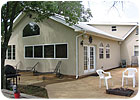
Both the exterior of the house and the 380-foot privacy fence are made of the same Dryvit exterior finish system, chosen for its adobe-like appearance.
Mixing wood and steel
McGuire has worked with the flexible track for years and has been quite pleased. “I love to work with curves and radii, particularly in remodeling jobs,” he said, noting that they can easily be constructed with wood or steel studs. “I can do anything with it. I can come from 9 inches down to virtually nothing.”McGuire is quite proud of his execution of a particular idea he got from a visit to Ceasar’s Palace in Las Vegas; a dramatic painted sky scene in the cathedral ceiling, which is lit by a large radius-arched window.
“When I saw that in Vegas I said ‘I want that in my house,’ and now I got a chance to do it. I painted it myself and wanted to see how it looked with the log loft setting. I loved it, so I kept it. It’s awesome!”
For the drywall corners throughout the house McGuire chose bullnose corner beads, by Trim-Tex. “I bullnosed everything,” he said. “It goes very well with the knocked-down adobe texture of the drywall.”
For the third phase of the remodeling effort, since he specializes in drywall and framing, McGuire says he wisely brought in some colleagues at his firm to take the lead on the installation of a Dryvit exterior system on his home, although he worked side-by-side with them on the 4,000-square-foot project for several months. “I know just enough about EIFS to get me in trouble if I do it myself,” he joked. He also added a matching privacy fence in the front of the house, constructed of the same system.
“I chose the Dryvit system for several reasons, one being the durability & low maintenance,” McGuire explained. “The second was to get the stucco look, since this is an older ranch house.
“I tore off all of the vinyl siding down to the original tongue-and-groove wood siding that is still in good shape. I then screwed Durock 4 x 8 panels over the wood and meshed the joints with a brown coat. A layer of mesh and 1/8-inch thick brown coat was next. Over that, I came back with the final EIFS finish layer and troweled it to the right texture.”
McGuire said he’s been delighted with the results. “It’s been more than three years already and I don’t have a single crack,” he said.
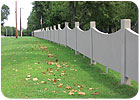
The fence has been a virtual tourist attraction, McGuire said. “People stop by at least once a month asking what it is, and if I would build one for them.”
Aside from the dramatic visual transformation of the exterior of the house, McGuire said his utility bills have dropped significantly. “My air conditioning bills went way down. Before, we could almost feel the air blowing around the windows.”
The fourth phase of the remodeling was completed this summer; a completely new kitchen. “I tore out a wall, added knotty pine cabinets, granite countertops and a very nice flex-arch over the center island,” he said.
McGuire sees a bright future for creative uses of the flex-arch with drywall, especially in the commercial sector, but also on the residential side as contractors become more accustomed to working with steel.
When he designed his family room with the serpentine soffits, he was quite mindful of the marketing value it would have for his firm.
“I had to do a lot of soul-searching when I decided to come back to Oklahoma after working on the beach in California,” McGuire said.
It’s turned out to be a great decision because his wife enjoys the Tulsa area, and the market is rewarding McGuire for proving that state-of-the-art creativity is not limited to California.
